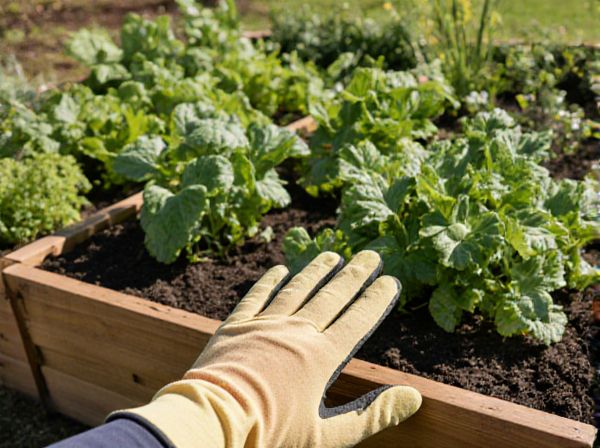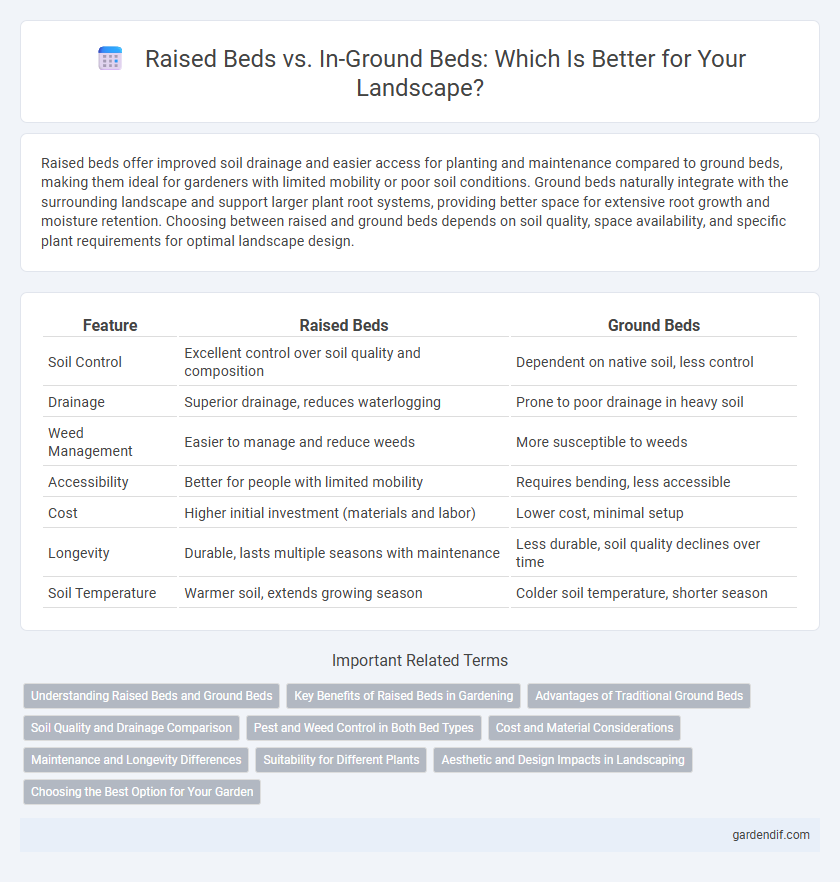
Raised Beds vs Ground Beds Illustration
Raised beds offer improved soil drainage and easier access for planting and maintenance compared to ground beds, making them ideal for gardeners with limited mobility or poor soil conditions. Ground beds naturally integrate with the surrounding landscape and support larger plant root systems, providing better space for extensive root growth and moisture retention. Choosing between raised and ground beds depends on soil quality, space availability, and specific plant requirements for optimal landscape design.
Table of Comparison
| Feature | Raised Beds | Ground Beds |
|---|---|---|
| Soil Control | Excellent control over soil quality and composition | Dependent on native soil, less control |
| Drainage | Superior drainage, reduces waterlogging | Prone to poor drainage in heavy soil |
| Weed Management | Easier to manage and reduce weeds | More susceptible to weeds |
| Accessibility | Better for people with limited mobility | Requires bending, less accessible |
| Cost | Higher initial investment (materials and labor) | Lower cost, minimal setup |
| Longevity | Durable, lasts multiple seasons with maintenance | Less durable, soil quality declines over time |
| Soil Temperature | Warmer soil, extends growing season | Colder soil temperature, shorter season |
Understanding Raised Beds and Ground Beds
Raised beds offer improved soil drainage, better root aeration, and ease of access for planting and maintenance, making them ideal for areas with poor soil quality or limited space. Ground beds rely on natural soil conditions, which can support larger plantings and deeper root systems but may require more soil preparation and weed control. Choosing between raised and ground beds depends on factors such as soil composition, garden size, and desired crop type.
Key Benefits of Raised Beds in Gardening
Raised beds improve soil drainage and prevent compaction, promoting healthier root growth and higher yields. Elevated soil temperatures in raised beds extend the growing season, enabling earlier planting and faster crop maturation. Enhanced control over soil quality and reduced weed pressure make raised beds an efficient and low-maintenance gardening solution.
Advantages of Traditional Ground Beds
Traditional ground beds offer superior soil biodiversity and natural drainage, promoting healthier root development for various plants. They allow easier access to native soil organisms and nutrients, enhancing soil fertility without the need for added amendments. Ground beds also provide greater flexibility in terms of size and shape, accommodating larger crops and deep-rooted plants more effectively than raised beds.
Soil Quality and Drainage Comparison
Raised beds offer superior soil quality due to controlled soil composition, reduced compaction, and enhanced organic matter incorporation compared to ground beds. Drainage in raised beds is significantly improved as elevated soil levels prevent waterlogging and promote faster water runoff, minimizing root rot risks. Ground beds often suffer from poor drainage in heavy or compacted soils, leading to slower water movement and potential nutrient leaching.
Pest and Weed Control in Both Bed Types
Raised beds offer enhanced pest and weed control by providing better soil drainage and easier access for manual weeding and pest inspection. Ground beds are more prone to weed invasion from surrounding soil and can harbor pests in untreated areas, making control more challenging. Implementing mulch and organic barriers in both bed types effectively reduces weed growth and deters common garden pests.
Cost and Material Considerations
Raised beds typically require materials such as wood, stone, or metal, which can increase initial costs significantly compared to ground beds that utilize the existing soil. Ground beds minimize expenses by eliminating the need for framing materials but may require soil amendments and weed control, impacting long-term maintenance costs. Selecting between raised and ground beds hinges on budget constraints, material availability, and desired soil quality enhancement.
Maintenance and Longevity Differences
Raised beds offer superior drainage and soil control, reducing the risk of soil compaction and weed growth, which lowers maintenance frequency compared to ground beds. Ground beds typically require more frequent weeding and soil amendments due to natural soil conditions and potential erosion. In terms of longevity, raised beds constructed with durable materials like cedar or composite wood can last over 10 years, while ground beds depend on ongoing soil health management for sustained productivity.
Suitability for Different Plants
Raised beds offer superior drainage and soil control, making them ideal for root vegetables like carrots and potatoes that require loose, well-aerated soil. Ground beds suit plants with deep root systems, such as trees and shrubs, benefiting from the natural soil profile and greater space. Leafy greens and herbs thrive in raised beds due to warmer soil temperatures and reduced soil compaction.
Aesthetic and Design Impacts in Landscaping
Raised beds create structured, visually striking elements that define garden spaces and add vertical interest, enhancing overall landscape design. Ground beds offer a more natural, seamless integration with the terrain, promoting organic flow and blending with existing vegetation. The choice between raised and ground beds significantly influences spatial perception, garden symmetry, and the balance between formal and informal aesthetics in landscape architecture.
Choosing the Best Option for Your Garden
Raised beds offer improved soil drainage, enhanced root development, and easier pest control, making them ideal for gardens with poor or compacted soil. Ground beds provide a natural ecosystem that supports beneficial soil organisms and are cost-effective, especially for larger planting areas. Selecting the best option depends on soil quality, garden size, and maintenance preferences to optimize plant health and yield.
Raised Beds vs Ground Beds Infographic

 gardendif.com
gardendif.com